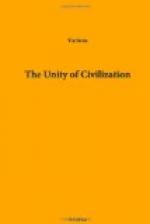But the dissolution of early European society and culture under the stress of contact with regions outside Europe is no matter of prehistoric times. The task of this essay is over when it has presented that society and culture as Man’s reasoned attempt to ‘live well’ in an exclusively European world.
BOOKS FOR REFERENCE
Marett, Anthropology. Home University Library.
J.L. Myres, The Dawn of History. Home University Library.
FOOTNOTES:
[Footnote 1: This chapter has not had the advantage of Prof. Myres’s revision, in view of the rest of the book which he has not seen. Being for some time abroad on war-work, it was impossible to communicate with him; and it is therefore thought best to print his paper just as it was written some months before the lectures were delivered.]
[Footnote 2: Herodotus, viii. 144. After the battle of Salamis, when the Athenians are invited by Xerxes’ envoy to desert the Greek cause, they say they cannot betray what ’is of one blood and of one speech, and has establishments of gods in common, and sacrifices, and habits of life of similar mode’.]
[Footnote 3: For details see the section on Herodotus in Anthropology and the Classics; and E.E. Sikes, The Anthropology of the Greeks.]
[Footnote 4: Thucydides i. 6 (Greek: polla d’ an kai alla tis apodeixeie, to palaion Hellenikon omoiotropa to nun barbariko diaitomenon).]
[Footnote 5: (Greek: tou gar logon eontos xynon, zoousin oi polloi os idian echoutes phronesin).]
[Footnote 6: (Greek: anthropoisi pasi metesti ginoskein eautous kai sophroneein).]
[Footnote 7: Thucydides, i. 5. He too, as it happens, is illustrating a primitive Old World, round the Aegean shores of Greece, by the contemporary West in the backwoods of Aetolia.]
[Footnote 8: Farrand, The Basis of American History, 1904, p. 270.]
[Footnote 9: The [Greek: balanephagoi andres], ‘acorn-eating men’, of Greek traditional ethnology.]
[Footnote 10: Bicknell, The Prehistoric Rock Engravings in the Italian Maritime Alps, Bordighera, 1902; Further Explorations, 1903. I begin to suspect that the stippled and shaded enclosures which accompany the drawings of oxen, ploughs, and men with hoes may represent the cultivation plots.]




